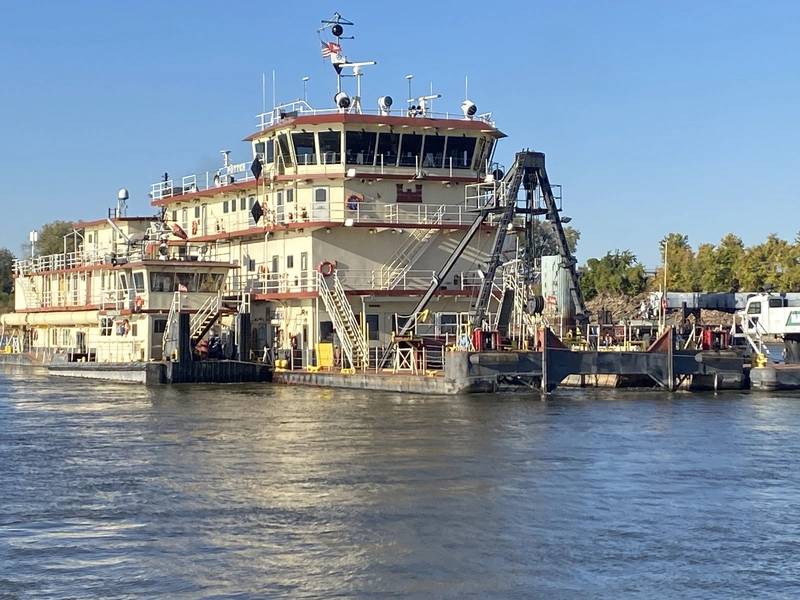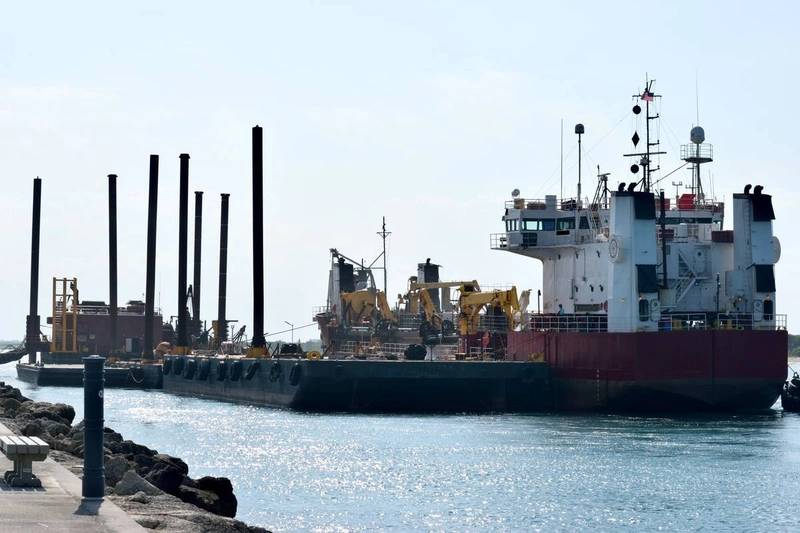US Dredging: Plenty of Issues, New WRDA on the Way
2024 marks another year for development of a biennial WRDA bill—Water Resources Development Act, critical legislation for the Nation’s waterways, ports and harbors. WRDA encompasses a range of issues, from environmental regs to energy use to agriculture and, of course, a focus on projects critical for economic growth.
Because these are dynamic and timely issues, Congress and the maritime sector like to keep WRDA on a two-year reauthorization timeline. Indeed, the House Transportation & Infrastructure Committee, December and January, held three WRDA information hearings. WRDA has two major parts: (1) it provides authority to study certain projects; (2) then the authority to construct, operate or maintain.

Dredging companies are one industry sector, of course, that closely monitors WRDA developments and, indeed, a 2024 WRDA bill is a high priority for the Dredging Contractors of America (DCA), the industry trade group based in Washington, D.C.
William Doyle is DCA’s chief executive officer, appointed by the DCA Board of Directors in June 2023. Prior to that, as Chief Executive at the Port of Baltimore, one of Doyle’s top projects was leading the effort with the Army Corps to finalize the $4 billion Chesapeake Bay Restoration Project Agreement, a commitment to dredge Maryland’s federal approach channels for the next 35 years.
In December 2023 DCA led a series of meetings on Capitol Hill with legislators and federal agency leadership, including meetings with Major General William Graham, USACE’s Deputy Chief of Engineers and Deputy Commanding General. DCA also met with Reps. Clay Higgins (R-La.) and Rick Larsen (D-Wash.). Higgins is on the Homeland Security Committee Subcommittee on Transportation and Maritime Security. Larsen is Ranking Member on the Transportation and Infrastructure Committee.
“We discussed the importance of a WRDA Bill making it through Congress and on to the President’s desk in 2024,” Doyle said. The meetings, he continued, provided an opportunity to highlight “how the U.S. private sector dredging industry is fiercely competitive and is delivering services that saves the federal government, and therefore taxpayers, hundreds of millions—$670 million in FY22 alone.” He said that new construction of Jones Act dredges—U.S. owned, built and crewed vessels—“have been rolling off the blocks for the past five years and will continue into the foreseeable future—over $2.5 billion in recapitalization.”
Doyle said DCA has been working on behalf of two other federal bills:
- The Reinvesting in Shoreline Economies and Ecosystems (RISEE) Act—S.373 and H.R. 913, bills to establish dedicated funding for coastal infrastructure and resiliency and create a new federal-state revenue sharing model from federal offshore wind revenue.
- The Budgeting for Renewable Electrical Energy Zone Earnings (BREEZE) Act, which passed the House in March 2023, but within another bill—H.R. 1 The Lower Energy Costs Act. (No action yet in the Senate.) BREEZE would establish parity for disbursing Gulf energy royalties.
Doyle said dedicated funding helps states’ cost-share portions, important for financing dredging projects.

Beneficial use
Beneficial use (BU) of dredged material remains a top priority for the industry, for Congress—and therefore for the Army Corps—and for project sponsors, states and environmental groups.
In WRDA 2022 Congress directed the Corps to file a report—“Strategic Plan on Beneficial Use of Dredged Material”—due one year after the bill was signed into law, making the Plan deadline December 2023. However, as of this writing (mid-February) the Plan remains unfinished. A Corps spokesperson said, “The report is in the final stages of coordination, but we do not have a firm date for when that will be complete.”
Still, the Corps filed some top-level beneficial use directives in 2023. In January, for example, Lt. General Scott Spellmon, 55th Chief of Engineers, issued a “Beneficial Use of Dredged Material Command Philosophy Notice,” outlining the Corps’ goal to beneficially use at least 70% of dredged material by the year 2030.
In August the Corps issued an update of sorts, a “Memorandum for Commanders, Major Subordinate Commands and District Commands. Subject: Expanding Beneficial Use of Dredged Material in the USACE.” This Memo is signed by Edward Belk, Jr, USACE’s Director of Civil Works. Belk writes that meeting the 70% goal by 2030 “will require innovation and commitment.” He adds that “the intent of this memorandum is to encourage robust innovation, planning, and categorization of dredged material for beneficial use.”
The memo references how beneficial use and disposal are categorized within USACE’s tracking systems. Plus, the memo introduces a third activity: “transitional placement,” i.e., “keeping sediment in the riverine or coastal system as a part of a management process or in a period of transition.”
In 2022, the Corps presented a Program Vision for BU, to meet the 2030 70% goal. The vision references key steps to be taken over the next 3-5 years; steps include best practices, innovative financing and partnerships. BU adds expenses to a dredge project, raising questions about who should pay, and how extra costs can be financed.
To help with such questions the Corps, in June 2023, presented a “Model Memorandum of Agreement for Beneficial Use of Dredged Material” (developed in response to a directive in WRDA 2020). The 20-page MOA addresses a range of issues and concerns that could arise with a BU project. First and foremost, it states that the non-federal interest will be responsible for 35% of the additional costs resulting from a BU project, i.e., the costs that exceed the cost of the government’s standard base plan.
Other high priority concerns include—
- HTRW—hazardous, toxic, radioactive waste. The non-federal interest is responsible for all costs pertaining to response and cleanup.
- Real property interests and relocations.
- Provision of non-Federal cost share. In effect, the project partner has to have its money ready upfront because the Federal government will draw down that money as the work moves forward.
Another important step to advance BU was publication, last May, by USACE’s Engineer Research and Development Center, of the document “Advances in Dredged Material Evaluations for Inland and Ocean Aquatic Placement.” The 185-page report is the first such update in 30 years.
San Francisco Bay—Key issues rising
In California, the San Francisco Bay Conservation and Development Commission (BCDC) is active on BU policy and projects. Brenda Goeden is BCDC Sediment Program Manager. She said that one ongoing project is the “Sediment for Wetlands Adaptation Project,” which started in 2022. Goeden said it has three parts: (1) a workshop to identify BU barriers and challenges and to develop a BU roadmap; (2) a potential San Francisco Bay Plan Amendment to further support beneficial reuse policy; and (3) a financing strategy to help identify funding. Goeden said workshops were held in January and February. Drafting the Roadmap is underway now and a document is expected to be ready for public review and comment in the next few months.
Goeden said a big project on the horizon is the proposed Oakland Harbor Turning Basins Widening Project. Currently, container vessels exceed the dimensions of the Bay’s turning basins. The project would expand maneuverability. Yes: dredging required. Dredging already maintains a 50-foot depth, which wouldn’t change, but since operational areas would expand so would dredging demands. Officials estimate turning basin maintenance will increase dredging volumes by up to 93,000 cubic yards annually.
Oakland Harbor released a draft environmental impact report in October. For dredgers, the report provides important insights into new operational challenges as dredging projects are required to align with and complement a project’s larger energy and environmental priorities.
For example, the port and USACE would develop a preconstruction sampling plan to determine whether dredged material is okay for beneficial use or requires landfill disposal. While there are some Bay and Port sites with known contamination, the expectation is that most dredged material will go for beneficial reuse, in this case, for wetland restoration.
Additionally, to prevent diesel related emissions, the project seeks to use electric dredging equipment that would plug into shore power. Electricity would come from a newly built substation near Berth 26 or the existing shore power connection in Alameda or a newly built connection on the Oakland Seaport side.
The report advises, however, that “the precise electric dredge that could be used is not known at this time, and the exact horsepower, location on the dredge, and configuration of the electric motors that would be part of the dredging system have not yet been determined.” The report is a bit unclear on some electric dredge references. Despite the unknowns about equipment, it writes that “all dredging activities would be conducted with an electric dredge.” The report states that general construction electricity use would be minor compared to the electric dredge, estimated to draw 1,237 kilowatts per hour.
But power might have to change depending on local energy use. If necessary, dredge operations could switch to diesel if brownout conditions were forecast during regional peak electric energy demands. One maritime industry group commented that “we agree with the finding that this project will benefit from the utilization of electric dredges in order to reduce the potential cumulative impacts of additional diesel particulate matter on the surrounding community.”
Finally, the Oakland Turning Basin Report states that BU can have beneficial climate impacts. The report estimates that, over 50 years, BU in wetlands could result in sequestering 11,848 metric tonnes of CO2 equivalents. These benefits, though, are questioned by the BCDC.
New issue on the horizon?
Last November the Congressional Research Service (CRS), which prepares legal and regulatory analyses for Members of Congress, published a Legal Sidebar report titled “Congressional Court Watcher: Recent Appellate Decisions of Interest to Lawmakers (November 20–November 26, 2023).”
The report summarizes about a dozen Appellate Court decisions across the U.S. The report advises that the “selected cases typically involve the interpretation or validity of federal statutes and regulations, or constitutional issues relevant to Congress’s lawmaking and oversight functions.”
One highlighted case involved dredging, mining for gold, in Idaho’s South Fork Clearwater River. The Idaho Conservation League charged that the dredger needed a U.S. EPA Section 402 Clean Water Act National Pollutant Discharge Elimination Permit (NPDES). The dredger said no: a Section 404 permit was sufficient; the permit overseen by the Army Corps. The Sec. 402 permit sets more rigorous demands. The Appeals Court agreed with a District Court’s decision in support of the Conservation League.
Some people comment that this case is one-off event about a person who should have known better. But there are issues that may deserve a closer look, especially as dredged material is increasingly moved around, starting in one place but ending up elsewhere, perhaps mixed with other material. The court’s decision, for example, impacts turbidity, suspended material and whether deposited material is actually the same material that was picked up. If not, deposition may be adding a pollutant to a waterway. “Nothing in the Clean Water Act,” the court writes, “says that once a material has been dredged, it remains a dredged material forever.” The court cites two issues of concern with dredging: waterway navigability and ecological health.
Congress may decide that ramifications from this case are limited. But maybe not. As dredgers know, WRDA discussions can cover a lot of topics.
(As published in the March 2024 edition of Marine News)
